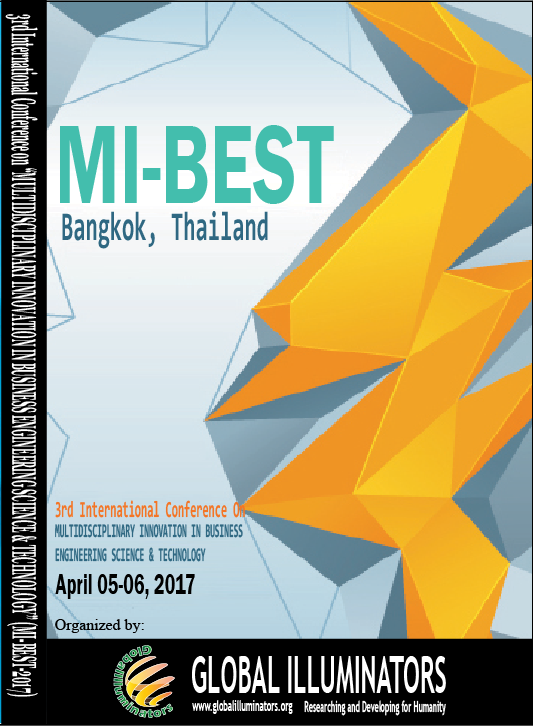
MI-BEST Proceedings
MI-BEST Proceeding
Volume 3, Pages 1-59
2017 MI-BEST Conference on “MULTIDISCIPLINARY INNOVATION IN BUSINESS ENGINEERING SCIENCE & TECHNOLOGY” (MI-BEST 2017)
April 05-06, 2017 Bangkok, Thailand
Edited by Dr. Ahmed Saddam
pp. 1-200 (2015)
2015 MI-BEST Conference on “MULTIDISCIPLINARY INNOVATION IN BUSINESS ENGINEERING SCIENCE & TECHNOLOGY” (MI-BEST 2015)
pp. 1-68 (2016)
2016 MI-BEST Conference on “MULTIDISCIPLINARY INNOVATION IN BUSINESS ENGINEERING SCIENCE & TECHNOLOGY” (MI-BEST 2016)
pp. 1-59 (2017)
2017 MI-BEST Conference on “MULTIDISCIPLINARY INNOVATION IN BUSINESS ENGINEERING SCIENCE & TECHNOLOGY” (MI-BEST 2017)
Track: Business Management & Economic Studies
Information Security Policy Mix and Strategic Choice for Information Security Compliance Intention Maximization
Pages 1-7
Hyun Kim
Abstract
Track: Social Science & Humanities
Constitutional and Participatory Model of Collective Judicial Proceeding: A Critical Study Based on the Theory of Class Actions as Thematic Class Actions
Pages 8-16
Juliana Maria Matos Ferreira, Reginaldo Gomes, Fabrício Veiga Costa, Vicente de Paula Maciel Junior
Abstract
critical understanding through the participation of all those legally interested parties in building the merits of Class Action Suits. Thus, this
research has the objective to present a legal debate about the problematic issue and to discuss the collective judicial proceeding untying it from autocratic and individualistic meanings. It is necessary to systematize all sparse Brazilian legislation regarding to Collective Rights with the purpose of seeking the construction of a legal system to protect the claims of diffused legally interested parties in a democratic way. Aiming at this theoretical context, we have to turn our minds to Class Action Proceedings under the critical view of the Supremacy Clause of the Constitution in order to implement the participation of those interested parties in the decision make according to the Theory of Class Action Suits as Thematic Action Suits. The scientific hypothesis that will lead to the whole study proposed in this research is centered on the following issue: Does the present model of Class Actions Proceedings proposed by the Instrumentalist ideological current corroborate the paradigm of the Democratic Rule of Law? Certainly not, since the fact that Class Action Proceeding have been discussed under the
model of representativeness, it is not enough to make feasible the direct participation of diffuse and collective interested parties in the
construction of the judicial decision, whose effects of it (decision) will affect all those subjects to whom the right of participation in the debate must be garanteed concerning to all themes related to the claims initially brought before the Courts.
Track: Engineering and Technology Studies
Automated Generation of Test Questions from Knowledge-Base
Pages 17-22
Assel Omarbekova, Alma Zakirova, Bayan Abduraimova, Sailaubek Duzelbayev
Abstract
Fragility Assessment of the Connection used in Small-Scale Residential Steel House Subjected to Lateral Wind Loads
Pages 23-29
Viriyavudh Sim, Jungkyu Choi, WooYoung Jung
Abstract
Typhoon disasters risk assessment is needed for small-scale residential houses with less than two stories or less than 500 square meters, since they accounted for about 55% of total buildings in Korea. Therefore, this study was focused on the evaluation of wind fragility for this small-scale lightweight steel frame structure when subjected to lateral wind loads. For this purpose, Monte Carlo Simulation technique was used to derive wind fragility based on random wind load parameters and experimental data of resistance capacity of the connection in this type of structure. Finally, the structural safety of a small-scale lightweight steel house was evaluated, and the fragility was derived. Results show that wind direction parallel to long dimension of structure was the most critical condition. Additionally, the median probability of failure occurs at a very high wind speed. Further research should focus on study with detail structural analysis to narrow down the uncertainty in this study.
Development of Wind Fragility for Window System in Lightweight Steel Frame House in South Korea
Pages 30-36
Viriyavudh Sim, Yongju Gwak, WooYoung Jung
Abstract
Typhoon disasters risk assessment is needed for small-scale residential houses with less than two stories or less than 500 square meters, since they accounted for about 55% of total buildings in Korea. Therefore, this study was focused on the evaluation of wind fragility for this small-scale lightweight steel frame structure when subjected to lateral wind loads. For this purpose, Monte Carlo Simulation technique was used to derive wind fragility based on random wind load parameters and experimental data of resistance capacity of the connection in this type of structure. Finally, the structural safety of a small-scale lightweight steel house was evaluated, and the fragility was derived. Results show that wind direction parallel to long dimension of structure was the most critical condition. Additionally, the median probability of failure occurs at a very high wind speed. Further research should focus on study with detail structural analysis to narrow down the uncertainty in this study
Track: Health and Medicine Studies
The Indigenous Aetas in Castillejos, Zambales: Practices and Preservation of Cultural Heritage
Pages 37-53
Emma C. Ventura, Daisy Soria
Abstract
This study aimed to understand, document and identify Aeta‘s cultural practices and their ways of preserving their cultural heritage at Sitio Kanaynayan, Barangay San Pablo, Castillejos, Zambales during the year 2016. It included the demographic profile of Aeta community as to their origin, language spoken, number of family members, number of female and male inhabitants, means of living, number of years in the place and mode of land acquisition. It also emphasized on describing and documenting some of their cultural practices such as dances, songs and musical instruments, religious beliefs, courtship, marriage and family relationships, education and other beliefs. The cultural practices towards preservation were then taken into account. The study involved the 147 inhabitants/residents of the community. The research used two approaches of research, quantitative and qualitative approaches – descriptive and ethnographic methods. The research techniques used semi-structured interviewing, participant observations and process documentation. Data revealed that majority of the households originated from the municipality of San Marcelino (Sitio Kakilingan, Cuartel, Ibad, Lumibao, speak the language/dialect Zambal-Botolan, most of the households have 5-6 and 3-4 members and most of the in habitants are female. The inhabitants are commonly engaged in vegetable and rice farming, stayed in the place for more than 10-20 years and have acquired their land through ancestral domain. The community folks provided information as to their cultural practices and beliefs. The Aeta people loved to dance their native talipe using native gong depicting animals such as monkeys, birds, butterflies or those in their environment. The people happily sang their dorodoh songs grouped as ―awada‖ and ―pangamba‖ using their gitaha or native guitar. They believe on their God as Apo Namalyari as the ruler and creator of everything. They practice ―bandi‖ or bride price such as in the form of cash, in kind or both .as early or when the girl reaches puberty. During the Mt. Pinatubo eruption, Aeta children were already encouraged to attend schooling since schools already exist right in their doorsteps. At present, the community has a complete set of elementary grade levels – Kinder to Grade VI. The community folks produce vegetables and other crops for market as means of livelihood. Other practices include naming of their children as ―Pan‖ as father and ―Indon‖ as mother or they associate the names of their children to anything that they experienced or encountered. In an interview conducted to indigenous folks in the community, out of the ten community folks, seven of them responded that they wanted to preserve their cultural practices particularly on their tribal dances ―Talipe‖ and folk songs ―Dorodoh‖. However, some of their cultural practices like ―Bandi‖ which is often misunderstood as buying a wife for some Aeta girls did not agree. Most of their practices are now influenced by the lowlanders such as their dresses, attending to church masses, treating them in hospitals and accept and recognize efficacy of medicines and other activities like Christians do. It is recommended that further studies be conducted to include the region of Central Luzon and other practices not specified in this study.
Track: Physical Life and Applied Sciences
Prevalence and Risk Factors of Musculoskeletal Disorders in Rubber Tappers: A Case Study in Phatthalung Province
Pages 54-59
S.Inraksa, A.Sungkhapong, K.Pochana
Abstract
This cross-sectional study presents the prevalence of musculoskeletal disorders (MSDs) among rubber tappers in Paphayom District, Phatthalung Province, Thailand. A total of 250 rubber tappers participated in this study. A general questionnaire was used to collect demographic background data and physical work characteristics while modified Nordic Musculoskeletal Questionnaire was used to determine the prevalence of MSDs (within 6 months). Descriptive statistics was used to describe the general data and prevalence. The factors affecting to MSDs and odds ratio (OR) were analyzed by inferential statistics at 95% confidence interval. The results showed that most participants were females (56.8%). The mean age of tappers was 42.1±12.6 years. The average work experience and Body Mass Index (BMI) were 12.6±8.3 years and 22.3±3.5, respectively. The prevalence of MSDs (in any body regions) in last 6 months was 36.40 (95%CI 30.42-42.69). The highest prevalence rates of MSDs were reported in lower back, upper back, hip & thigh regions (30.4%, 6.8% and 6.0%, respectively).Risk factors which were significantly resulted in MSDs were age of workers, work experience, and handedness behavior. The significant risk factors related to working conditions were plantation ground level, tapping light, handedness, grip tightness, standing posture, age of rubber tree, and tapping height. This study reveals that rubber tappers were suffering acute MSD (for the past 6 months) on low back area. Various risk factors were found to be significant. Rubber tappers who were exposed to a combination of risk factors may have an increased risk of developing MSDs. Further study with comprehensive strategy is essential in order to determine the need of appropriate intervention and health promotion for rubber tapper.
